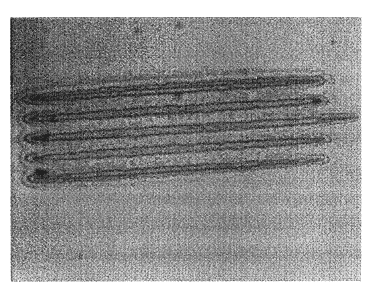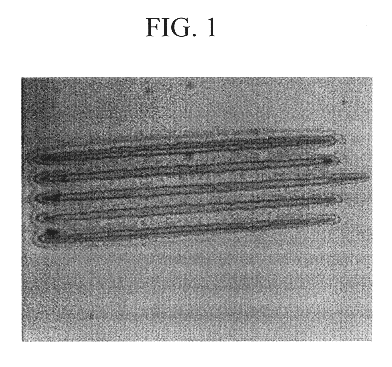Methods for the lithographic deposition of materials containing nanoparticles
a technology of nanoparticles and lithographic deposition, which is applied in the direction of solid-state diffusion coating, plasma technique, heat inorganic powder coating, etc., can solve the problems of not being able to disclose a photochemical technique of converting precursor materials into metal or metal oxide films with imbedded nanoparticles
- Summary
- Abstract
- Description
- Claims
- Application Information
AI Technical Summary
Problems solved by technology
Method used
Image
Examples
example 2
In a similar experiment to Example 1, micron scale CdS particles were prepared by a modification of the method of Dona and Herrero. A solution of thiourea (10 mmol), cadmium acetate (10 mmol), and ethylene glycol (0.4 mL) in a 150 mL aqueous ammonium chloride / ammonia buffer (pH 10) was prepared. A glass substrate was inserted into the solution and this solution was heated to 80.degree. C. overnight. The solution was allowed to cool and the adherent CdS particles were collected on the glass substrate which was removed from the solution. These particles were suspended in petroleum ether and combined with a Mn(II) 2-ethylhexanoate in petroleum ether solution. This solution was spin coated onto a silicon surface and photolysis resulted in the formation of nanoparticles embedded on the surface of the thin manganese oxide film.
PUM
| Property | Measurement | Unit |
|---|---|---|
| volumes | aaaaa | aaaaa |
| pH | aaaaa | aaaaa |
| plasma | aaaaa | aaaaa |
Abstract
Description
Claims
Application Information
 Login to View More
Login to View More - R&D
- Intellectual Property
- Life Sciences
- Materials
- Tech Scout
- Unparalleled Data Quality
- Higher Quality Content
- 60% Fewer Hallucinations
Browse by: Latest US Patents, China's latest patents, Technical Efficacy Thesaurus, Application Domain, Technology Topic, Popular Technical Reports.
© 2025 PatSnap. All rights reserved.Legal|Privacy policy|Modern Slavery Act Transparency Statement|Sitemap|About US| Contact US: help@patsnap.com


